I Purpose
These guidelines aim to prevent industrial accidents in sling work, etc.
by taking safety measures for sling work, etc. using cranes, mobile cranes,
derricks or deck cranes (hereinafter referred to "cranes, etc."),
together with the requirements of the related legislation on the Industrial
Safety and Health.
- II Responsibility of the employer, etc.
The employer when performing sling work, should make effort on accident
prevention by taking proper measures for sling work, etc. according to
these guidelines.
Workers engaged in sling work should make effort on accident prevention
by performing safe sling work under these guidelines as well as cooperating
with the safety measure taken by his employer according to these guidelines.
- III Measures to be taken by the employer
- 1 Provision of work standard, etc
The employer should provide the work standard in which, corresponding to
the type and content of material handling work including sling work (hereinafter
referred to as "sling work, etc."), the formation of workers
engaged, work description among an operator of cranes, etc., slingers,
a signaler, etc., the type and capacity of cranes, etc. to be used, the
sling gear to be used and signaling are prescribed and at most care for
ensuring safety in sling work, etc. are considered. And the employer should
also make it fully notice to the workers concerned.
When performing the sling work, etc. that the work standard is not provided,
the employer should, before commencement of the sling work, etc., provide
the work plan clarifying the items to be included in the work standard
and notice it to workers involved.
- 2 Determining the work assignment on sling work, etc.
The employer should, according to the predetermined work standard or work
plan and taking into account of the mass or shapes of loads to be handled,
decide the assignment of a crane operator, slingers, a signaler, assistants,
etc. and appoint a person who acts as a supervisor for the sling work,
etc. (hereinafter referred to as "lifting supervisor") among
the workers engaged in the sling work, etc.
And the employer should inform the lifting supervisor of the items related
to the type, the mass, the shape and quantity of loads, transporting course,
etc.
3 Coordinating meeting before commencement of the work
When performing the sling work, etc., the employer should have his lifting
supervisor hold the coordinating meeting with the workers concerned and
have him indicate and notice following items to workers engaged in the
sling work, etc.
- Outline of work
- Matters concerning loads to be slung
To make known to all concerned the type, mass, shape and quantity of loads
to be slung.
- Matters concerning the working area including transporting routes
To make known to all concerned the working area including the transporting
routes, the condition of buildings, temporary structures, etc., as well
as the conditions of any other work in case other work is taking place
within such working area.
- Matters related to the positioning of workers
To make known to all concerned the work positioning of slingers, a signaler
and assistants, and evacuation sites during transportation, and the positioning
of the workers assigned to prevent loads from swinging in case that the
work is required.
- Work procedures
-
Matters related to slinging methods
To provide slingers with instructions on the type and quantity of sling
gear to be used as well as the slinging method. In addition, to determine
a main person in charge in case multiple workers are engaged in sling work.
- Matters related to cranes, etc., to be used
To make fully known to all workers engaged in sling work the specifications
of the cranes, etc., to be used (rated load, working radius). In addition,
in case of using a mobile crane, to make an operator of such mobile crane confirm the installation location,
installation direction and overturn prevention measures.
- Matters related to signaling
To give specific instructions on the signals to be used, and also to make
sure that the workers involved confirm the meaning of such signals.
- Matters related to coordination with other work
In case other work is being conducted along the transporting route, To
appoint personnel to instruct the workers performing such other work to
move from the route, as well as to instruct said workers on the evacuation
timing and evacuation sites.
- Matters related to measures in case of emergencies
In case any unsafe conditions are observed, To ensure that all workers
confirm the suspension of the work, as well as provide instructions to
the operators of cranes, etc., on the method to signal the suspension of
work in the event they sense danger.
4 Implementing sling work, etc.
During sling work, etc., employers should indicate personnel in charge
to implement the following.
- Matters to be implemented by personnel in charge of lifting supervision.
- Confirm that the mass, shape and quantity of the load to be lifted are
as instructed by the employer, as well as confirming that the type and
quantity of the sling gear to be used are appropriate, and if necessary,
chang or replace the sling gear.
- Confirm the installation situation of the cranes, etc., as well as the
condition within the working area including the transporting route, and
take whatever steps are necessary to remove obstacles, etc.
- Confirm that the slinging method is appropriate, as well as instruct the
slingers to make whatever improvements are necessary in the event it is
appropriate.
- In case any unsafe condition is observed, such as the potential danger
that the load may fall, take immediate steps such as instructing the crane
operator, etc., to suspend the work and lower the load to the ground.
- Matters implemented by slingers.
- Prepare the sling gear used in sling work, and also check sling gear, and
make suitable replacements in the event any damage, etc., is observed.
- Confirm that the mass and shape of the load are as instructed, and also
confirm that safe operations can be carried out with the prepared sling
gear, and request the personnel in charge of sling work to change the slinging
methods or replace the sling gear if necessary.
- In carrying out sling work, determine the center of gravity of the load,
conduct the sling work by the methods instructed at the work meeting, and
signaling to the signaler upon evacuating to a safe location. In addition,
confirm the condition of the lifted load when lifted off the ground, and
taking steps such as returning the load to the ground for re-slinging if
necessary.
- When landing a load, confirm the condition of the location where the load
is to be set down, and take steps to stabilize the load by deploying sleepers,
stoppers, etc. In addition, detaching the sling gear upon confirming the
stability of the load after it has been set on the ground.
- Matters to be implemented by a signaler
- Position oneself in a location with a view of the operator of the crane,
etc., and the slingers, and upon receiving a signal from the slingers,
give a signal to the operator of the crane, etc., after confirming that
the related workers and any third parties are at the safe place.
- Always monitor the lifted load, and guide the load while confirming the
condition of the transporting route such as making sure that no workers
are under the load.
- When the lifted load becomes unstable, immediately send a stop signals
to the operator of the crane, etc., and suspend the operation.
- When landing a lifted load, confirm the condition of the landing location and the location where the
slingers are standing by.
-
Matters to be
implemented by the operators of cranes, etc.
- Inspect the cranes, etc., to be used before starting work. In case of using
a mobile crane, confirm the ground condition, and install the mobile crane
on the basis of the instructions provided at the work meeting upon requesting
such steps as the reinforcement of the ground and taking whatever other
steps are necessary.
- Confirm the condition of the working area including the transporting route,
and request lifting supervisor to take steps such as removing obstacles
if necessary.
- When worker enters into the area under the lifted load, immediately stop
crane operations and instruct such worker to evacuate the area.
- In the event of any possibility of exceeding the rated load during transporting
the lifted load, immediately stop crane operations and take the necessary
steps by informing the lifting supervisor of the situation.
5 Selecting the slinging method
When performing sling work, the employer should ensure that the work is
conducted in consideration of the following depending on the slinging method.
- Common matters
- In selecting sling gear, secure the necessary safety coefficient or use
such gear within the range of the specified working load, etc
- In principle, the lifting angle ("a" in Figure 1) shall be 90
degrees or less.

- When slinging a load by the choker hitch using a shakle and a wire rope
sling, make certain that an eyebolt passes through an eye of the wire rope
sling.
- Make certain that the wire rope slings do not overlap each other at the
top or sides of the hook, etc.
- Do not directly touch the lifted load or sling gear while the crane, etc.,
is moving.
- When removing the sling gear such as the wire rope sling, do not pull it
by hoisting a hook etc.
- Method using wire rope slings
Conduct all sling work by paying attention to the following under the standard
slinging methods, respectively.
- Two-leg with two-point lifts, and four-leg with four-point lifts, four-point
lifts (Figures 2 and 3, respectively)
- In case of two-leg lifts, confirm that the metal fittings for lifts are
attached above the center of gravity to prevent the load from turning over.
- Make certain that no eyes overlap on the hook and hitch all eyes in accordance
with the direction of the hook.

- Double wrap basket hitch by two-leg with four-point, (Figure 4);double
wrap choker hitch by two-leg with two-points(Figure 5)
- Avoid any overlapping of the wire rope at the wrapped part.
- In case of deep choker hitch, assume that the sling is subject to two to
three times the normal working tension and therefore select the appropriate
wire rope slings that stand against tension.
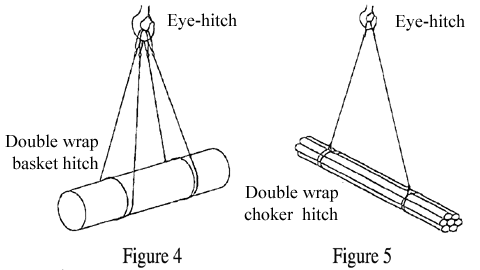
- Two-leg with four-point basket hitch (Figure 6)
Because of the poor stability of the lifted load (the wire rope slings
hitch positions may shift due to shaking the load during conveyance, etc.),
the lifting angle should be 60 degrees or less in principle. Steps should
also be taken to prevent the wire rope from slipping out of position by
using anti-slip pads, etc.
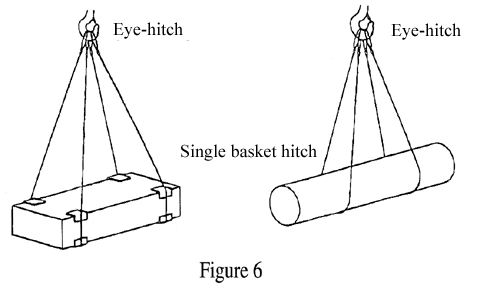
- Two-leg with two-point choker hitch (Figure 7)
- In case of using a shackle, follow C under 1 (Common matters) stated above.
- Use this method for a load so that extreme stress is not applied on the
metal steeve of the wire rope slings
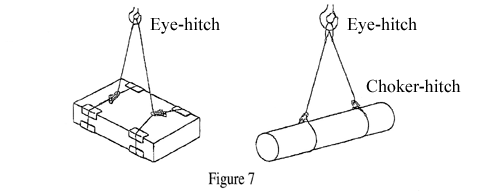
- Adusting hitch with three-points (Figure 8)
- Use the adusting gear (chain block in the figure) on the support side.
- Hitch eyes of the wire rope sling on the upper and lower hooks of the adjusting
gear
.
- Handle the adjusting gear with no load condition.
- In case of double wrap choker hitch, choker hitch or single wrap basket
hitch at the support side, make sure that the angle of the wire rope slings
such that it will not slip sideways (the angle as shown in "a"
of Figure 8 is some 60 degrees or less).
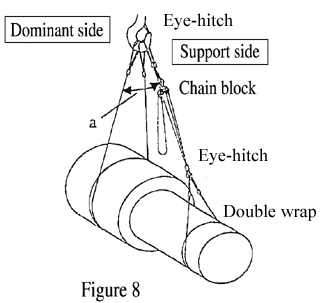
- Cross-hitch (Figure 9)
- Intersect the wire rope slings at the center of the bottom of the load..
- Select wire rope slings on the assumption that approximately two times
the normal working tension will act on the intersecting part.
- Methods using clamps and hooks.
- Strictly observe the working load and the working range specified by the
manufacturer.
- In case of using general-purpose clamps, use at least two or more of the
clamps that are suitable for the shape of the load.
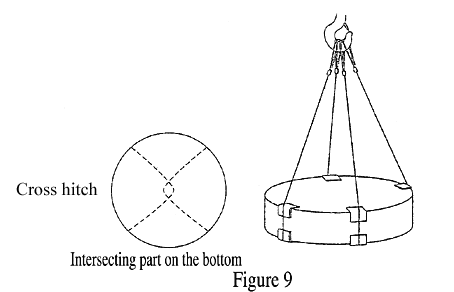
- Keep the lift angle ("a" in Figure 10) at 60 degrees or less.
- In case of using horizontal-lift clamps, keep the hitch width angle (fÆ
in Figure 10) at 30 degrees or less.
- Do not use these for loads that may be broken or deformed due to the compression
force of the clamps at the time of the load lifting.
- In case of anything adhering to the surface of the
load (such as grease or paint), be sure to remove them well in advance.
- Do not use lifting hooks that have been welded or remanufactured.
6 Check,inspection and maintenance
Employers should conduct the inspection, repair, etc., of sling gear such
as wire rope slings in accordance with the following.
- Establish periodic inspection interval and appoint the person in charge.
- Implement the inspections in accordance with the inspection methods and
criteria shown in the annexed table, and take the necessary steps according
to the results of such inspections.
- In case the results of such inspections reveals
that repairs are necessary, do not conduct such repairs by using heating,
welding or localize high pressure.
- Use the appropriate methods in storing sling gear, and give proper attention
to the prevention of corrosion, damage, etc.
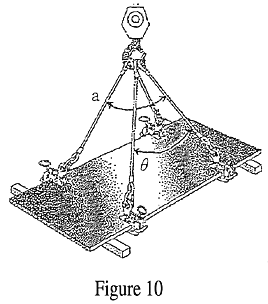
Annexed table
Inspection method and its criteria
(1) Wire rope
sling
| Part to inspect |
Inspection method |
Criteria |
Wire rope
|
- Check visually for number of broken wires in one lay.
- Check a rope diameter for wear by a caliper.
- Check visually for kink.
- Check visually for deformation.
- Check visually for rust or corrosion.
- Check visually for deformation at eyes.
- Check visually for looseness at eyes.
|
- Broken wires shall be less than 10 % of element wires in one lay.
- The diameter decrease shall be less than 7 % of the nominal diameter.
- No kink.
- No marked deformation.
- No marked rust or corrosion.
- No marked deformation.
- No looseness.
|
| Pressed metal sleeve |
- Check metal sleeve for wear by caliper or flaw.
- Check sleeve for deformation, etc.
|
- The sleeve thickness shall be two third or more of the original thickness.
- No marked deformation.
|
(2) Chain sling
| Part to inspect |
Inspection method |
Criteria |
| Chain |
- Check for elongation.
- Check for the overall deformation and twist.
|
- The elongation in five links shall be less than 5 % of the original length.
- No marked deformation or twist.
|
| Link |
- Check the link diameter for wear.
- Check for crack, deformation, twist or bend.
|
- The decrease of link diameter shall be less than 10 % of the original one.
- No marked crack, deformation, twist, wear or bend.
|
(3) Belt sling
| Part to inspect |
Inspection method |
Criteria |
| Belt |
Check for damage (wear, flaw) |
- Seams shall be clearly identified. No marked defect such as damaged warp,
rough shag.
- Flaws shall be less than one tenth of the belt width and one fifth of depth of the belt thickness.
- n the case that the use limit is provided, the limit display does not remarkably appear or is not disappearing.
|
| Eyes |
Check for damage (wear, flaw) |
- Seams shall be clearly identified. No damaged warp.
- No marked scratch, abrasion, etc.
- The eye form is kept correctly, even if some of sewing thread is cut
- No separation at sewn joint.
|
| Metal fitting |
Check for damage (deformation, crack, corrosion) |
- No deformation.
- No marked damage by hitting, scratch.
- No crack.
- No marked corrosion.
|
(4) Hook
| Part to inspect |
Inspection method |
Criteria |
| Hook |
- Check for the opening throat
- Check for the twist
- Check for cracks
|
- The dimension of the opening throat shall be less than 5 % of the original
opening.
- No marked twist
- No marked crack
|
(5) Clamp
| Part to inspect |
Inspection method |
Criteria |
| External appearance and function |
- Check for deformation and twist.
- Check the function of a cam and lock for abnormality.
- Check for crack, rust or arc strike.
|
- 1 No marked deformation or twist.
- The cam and lock shall work correctly.
- No crack, rust or arc strike.
|
| Cam and jaw |
- 1 Check tooth for lack or wear.
- Check for crack, rust.
|
- 1 The lack and wear of tooth shall be within the limit indicated by the
manufacturer.
- No crack or marked rust.
|
| Pins |
- Check for bend.
- Check for wear.
|
- No bend.
- No marked wear.
|
(6) Lifting hook
| Part to inspect |
Inspection method |
Criteria |
| Hook |
- 1 Check for elongation, twist, opening, deformation of width.
- Check for hit flaw, dullness and damage at hook point.
- Check for crack.
|
- No elongation, twist, opening, deforma- tion.
- No flaw, dullness or damage.
- No marked crack.
|
| Arc strike |
Check for arc strike. |
No arc strike |
(7) Shackle
| Part to inspect |
Inspection method |
Criteria |
| Body |
- Check for opening, shortening, twist and wear.
- Check for crack.
- Check for wear and damage of screw by an eyeboltk.
|
- No opening, shortening, twist or wear.
- No crack.
- No abnormality.
|
Eyebolt,
bolt and pin |
Check for bent, crack and wear. |
No bent, crack or wear. |
|
|







